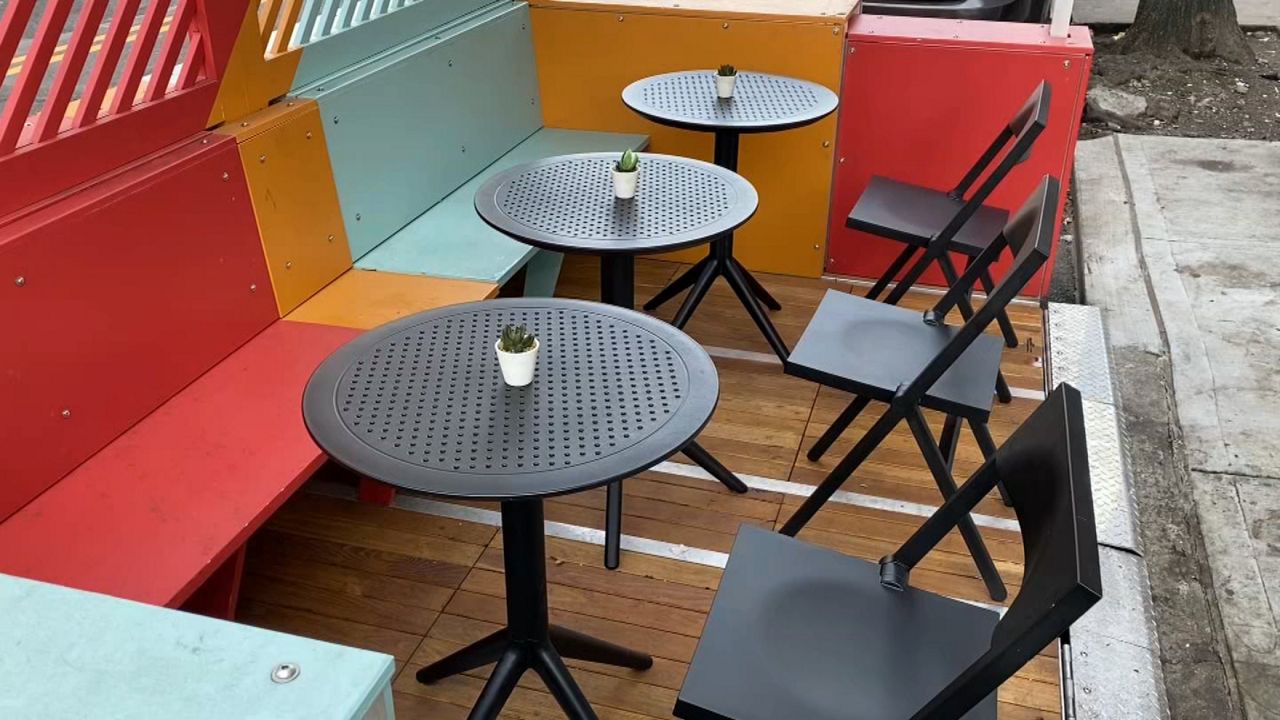New data shows a growing number of commercial buildings in New York City have more debt on the building than they are currently worth.
It's part of the changes to the commercial real estate market caused by the COVID-19 pandemic altering the way many New Yorkers work.
Eventually, property owners will be left asking an important question: Is it worth holding onto their buildings?
Real estate analysts told NY1 it is something they are watching, with a lot of commercial real estate loans sunsetting by next year and needing to be refinanced.
The problem now is more than one in five office spaces are sitting empty in New York City, according to a New York University and Columbia University study. So many buildings are bringing in less revenue while at the same time, their commercial loans are up to be refinanced during a time when interest rates are significantly higher.
Higher costs and declining revenue will leave some property owners at the point where they may just give up the building and hand the keys back to the lender.
NY1 reached out to dozens of commercial real estate companies, lawyers, and banks to try to understand how many buildings could be in danger of this happening.
"As a rule properties with loans coming due and significant vacancies are likely candidates," said Jeffrey Gural, the chairman of GFP Real Estate, in an email to NY1.
He added none of his buildings were in danger.
One lawyer told NY1 he had two clients who have offered their buildings back to the lenders.
Most companies declined to comment. That includes Brookfield Properties as well as Mack Real Estate – the parties involved in a recent transaction at 1619 Broadway, better known as the Brill Building.
In the middle of the 20th century, writers came up with hit after hit inside the halls of that building.
However, city documents show Brookfield Properties transferred the property to Mack Real Estate, which had lent Brookfield Properties money for the building.
The real estate firm JLL also has research that shows more than 500 commercial buildings in Manhattan have lost value since their purchase price, totaling more than $38 billion.
Additionally, 112 buildings have more debt on them than they're valued at, according to internal models calculated by the firm. That data is from the second quarter of 2023. In the first quarter, there were 73 buildings in that position, known as “being underwater.”
Real estate analysts said there are many factors that go into whether a building goes into default. That includes the financial outlook for the company in charge, the long-term potential – or lack thereof – for the building and neighborhood, the building's amenities and whether leasing is trending towards a more promising or concerning direction.
New data from the commercial real estate firm Trepp shows there are more than 70 delinquent commercial buildings in the five boroughs.
The delinquency category can range from owners being late on loan payments to foreclosure, according to Stephen Buschbom, a research director at Trepp.
The final step in the foreclosure process is defaulting.
Trepp reports the delinquency rate for office loans in the city was only 0.19% in December 2022. It rose to 2.07% in June of this year. Though, the figures are still far off from the 5.1% in 2011 seen after the Great Recession.
However, Buschbom said he fears the numbers later this year and next could get worse with billions of dollars in loans set to need refinancing by the end of next year.
“That’s when we’re really going to be looking to see what percentage of maturing loans end up defaulting,” he said.
He noted just because buildings are in foreclosure – or simply delinquent – there can be solutions and off-ramps to avoid default.
"Fortunately, there’s a willingness to try to work through these issues if the borrower wants to stay invested in the property," he said.
The challenge, he added, is that the refinancing conditions are really difficult.
"For loans coming due this year the high rates, the constrains, the tighter credit conditions, they’re just facing almost impossible odds to refinance an office building because so many lenders are just saying we’re not touching that at all," he said.
The fear, according to researchers like Buschbom, in a worst case scenario, a bank takes control of a building. And they are not always in the business of running a building – or even want the building. And that can have a damaging impact on the building longer-term.
"The signal that sends to the marketplace. Tenants looking for space are probably going to be hesitant to go and lease space that is suffering financially and facing receivership," he said. "Whereas if the borrower has committed themselves to the property, they still have the ability to turn it around.”
In a memo this summer, the Federal Reserve called for banks to work with borrowers when possible.
And commercial real estate attorney Natalia Sishodia said she's seen that firsthand with her clients. She said she had at least three clients in the city ready to hand over their buildings to lenders, but they did not in the end after working out compromises with the banks.
“If they don’t they would end up with this commercial spaces and this is not something banks really want to do,” she said.
One option would be for banks to go back to a program that was used in the wake of the financial crisis in 2008, according to Douglas Durst, the chairman of the Durst Organization. He is calling for a return of extend and pretend, which is effectively pretending the loan conditions should continue as is to a date later down the road. It kicks the maturity date of the loan further down the road, in hopes the owners and market will turn around, delaying the need to refinance.
Durst said none of his companies 13 commercial properties are in a position where they may go into default.
He’s said he’s invested in his buildings, adding amenities. He added that those owners who have already invested should be doing well.
During the lunch hour after NY1 interviewed Durst by the Bank of America Tower, one of the firm's properties, the area was packed. Several lunch spots had lines out the door.
Durst said property owners who did not may have trouble attracting tenants.
“It’s a double whammy so to speak," he said. "They need to bring more people to the building. And they need to borrow money to do that.”
Data from the Real Estate Board of New York, where Durst is the chairman, shows the highest number of people back in the office since 2019. However, that number is still 27% below the 2019 mark.
Several real estate experts consulted by NY1 agreed older office buildings are most vulnerable to this new commercial real estate market.
Another outstanding question is what sort of impact the change in commercial real estate will have on property tax revenue.
A joint study from New York University and Columbia University this spring predicted office values in the city will decrease by 44% by 2029.
Property taxes are the largest form of revenue for the city, according to the New York City Independent Budget Office. The city’s comptroller released a report this summer that about 20% of city property tax revenue comes from these buildings.
In that report, there's a chart with potential outcomes for property tax revenues in the next few years.
The baseline has an increase in revenue by tens of millions of dollars in fiscal year 2025 and hundreds of millions of dollars more in 2027. But the pessimistic forecast projects a decrease in revenue from that baseline of at least $120 million each year from 2025 to 2027. The doomsday scenario would yield a more than $1.1 billion decrease compared to that 2027 original projection.






_CC_PKG_Manufacturers_Tariffs_133971722_389)

_Pkg_Trump_Tariffs_Jackson_Heights_Rest_Reax_Clean)
